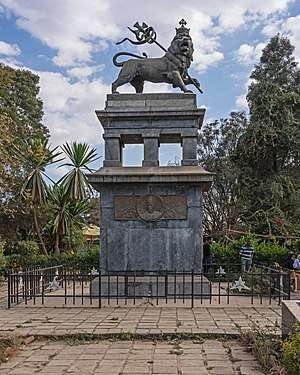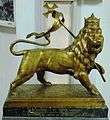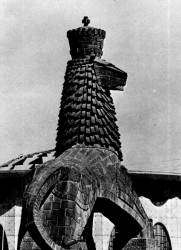Monument to the Lion of Judah
The monument to the Lion of Judah is a statue of the Lion of Judah, symbol of Ethiopian Emperors and Ethiopia is located in Addis Ababa.[1][2]
| Monument to the Lion of Judah | |
|---|---|
 | |
| Artist | Georges Gardet |
| Year | 1930 |
| Type | sculpture |
| Medium | gilded bronze |
| Location | Addis Ababa, Ethiopia |
History of the monument
.jpg)
The monument is located in the square of the Addis Ababa railway station in Addis Ababa and marks the end of Winston Churchill Avenue, one of the main arteries of the city.[5] The sculpture of the Lion of Judah, in gilded bronze, is placed on a black granite pedestal decorated with relief portraits of Menelik II, Haile Selassie I, Zewditu, and ras Makonnen Wolde Mikael. The work was made by the French sculptor Georges Gardet in 1930, on the occasion of the coronation of Emperor Hailé Selassié on November 2,1930. After the 1974 revolution, the Derg regime thought of removing the monument, symbol of the monarchy, but an association of Arbegnoch veterans claimed that it was a memory of Ethiopian antifascist resistance and a symbol of Ethiopia. So, the regime agreed to leave the monument, which is still in front of the Addis Ababa central station.[6] In 1954 a new monument was commissioned by Emperor Hailè Selassiè from sculptor Maurice Calka.[7] [8]
The monument brought to Rome

At the end of the so-called March of the Iron Will (in italian: Marcia della ferrea volontà) (during the Second Italo-Ethiopian War) that led to the occupation of Addis Ababa by the Italian army, the statue was transported to Rome, Italy in 1935 at the end of the Second Italo-Ethiopian War.
The Lion of Judah sculpture was placed just beyond Square of Five hundred to Rome, under the obelisk that remembers of the Battle of Dogali on May 8, 1937, on the occasion of the first anniversary of the proclamation of the Italian Empire. The Lion of Judah statue remained in Rome until the 1960s, when it was returned to Ethiopia after the negotiations in Addis Ababa. Emperor Haile Selassie took part in the new inauguration ceremony in military uniform, also recalling the patriotic gesture of Zerai Derres.
Zerai Derres history in Italy
On June 15, 1938 the young Eritrean Zerai Deres made a protest against the Italian occupation of Ethiopia in front of the monument. Brandishing a scimitar, he wounded several onlookers and was shot by soldiers.[9][10] He was arrested by the fascist militia and imprisoned in a psychiatric hospital (however, contemporary Italian historians doubt the claim that he was mentally unstable) in Sicily, where he died in 1945. For this gesture Zerai Deres is considered a national hero both in Eritrea and Ethiopia.[11][12][13]
Gallery
The Monument to the Lion of Judah in Addis Ababa
 Monument to the Lion of Judah, Addis Ababa
Monument to the Lion of Judah, Addis Ababa.jpg) Lion of Judah
Lion of Judah.jpg) Lion of Judah Monument
Lion of Judah Monument Lion of Judah sculpture
Lion of Judah sculpture.jpg) The Lion of Judah
The Lion of Judah.jpg) Lion of Judah Monument Maurice Calka Sculptor
Lion of Judah Monument Maurice Calka Sculptor.jpg) Lion monument, Maurice Calka
Lion monument, Maurice Calka- Lion monument Addis Ababa
 Lion of judah, Maurice Calka Sculptor
Lion of judah, Maurice Calka Sculptor- Lion of Judah, Addis Ababa, Ethiopia
 Lion of Judah Addis Ababa
Lion of Judah Addis Ababa
Note
- Rubenson, Sven (1965). "The Lion of the Tribe of Judah Christian Symbol and/Or Imperial Title". Journal of Ethiopian Studies. 3 (2): 75–85. JSTOR 41965727.
- "The Crown Council of Ethiopia".
- high.http://ateliercalka.net official site
- https://web.archive.org/web/20090429075703/http://www.a360.org/CB/CALKA.htm Benoit Teillet photography in Maurice Calka workshop in 2001
- Jean-Bernard Carillet; Stuart Butler; Dean Starnes (2010). Etiopia e Eritrea. Lonely Planet. p. 86. ISBN 9788860405456.
- "Imperial Monuments of Ethiopia". 2015-07-26.
- high.http://ateliercalka.net official site
- https://web.archive.org/web/20090429075703/http://www.a360.org/CB/CALKA.htm Benoit Teillet photography in Maurice Calka workshop in 2001
- "Tre persone ferite da un eritreo impazzito". Il Messaggero (in Italian). 1938-06-17. p. 4.
- "Ethiopian runs amok in Rome; hacks four persons with sword". Chicago Daily Tribune. 1938-06-16.
- "The Global Security Architecture, Human Rights Violations and the UN in the 21st Century Part I". Minister of information of Eritrea. 2015-10-07.
- Alberto Sbacchi (1985). Ethiopia under Mussolini: Fascism and the Colonial Experience. London. p. 138., cited in Lionel Cliffe; Basil Davidson (1988). The Long Struggle of Eritrea for Independence and Constructive Peace. p. 71. ISBN 9780932415370.
- Alessandro Triulzi (2015). Paolo Bertella Farnetti; Cecilia Dau Novelli (eds.). Across the Mediterranean. Acknowledging Voices and Silences of (Post)Colonial Italy. Colonialism and National Identity. Cambridge Scholars Publishing. pp. 161–176.
Filmography
- The Lion of Judah, life and Reign of Haile Selassie I (Roland van Reenen) on YouTube (19 January 2012)
- The Lion of Judah, Prince Ermias Sahle Selsssie (LibraryOfCongress) on YouTube (3 April 2011)
- Monuments of Addis Ababa, EthiopiaIl (Ethiopian TV) on YouTube (7 March 2013)
- Il leone di Giuda (Cinegiornale Luce) on YouTube (3 March 1937)
- Scoperto il Leone di Giuda portato da Addis Abeba (Cinegiornale Luce) on YouTube (12 May 1937)
See also
| Wikimedia Commons has media related to Monument to the Lion of Judah. |